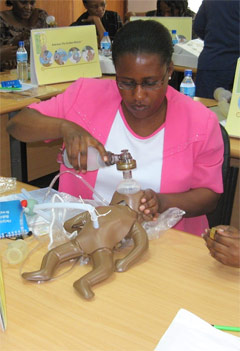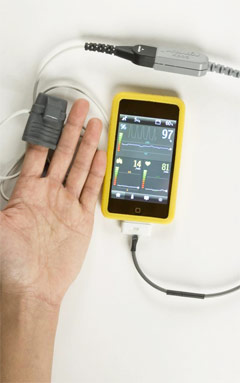Top 10 Health Care Innovations to Save Mother & Child

In an effort to save the
lives of 16 million women and children by 2015, PATH,
an international nonprofit organization that transforms global health launched
Breakthrough innovations that can save women and children. The report was
presented at a high level UN panel at the United Nations General Assembly this
week. The panel included Jens Stoltenberg, Prime Minister of Norway Bill Gates,
The Bill & Melinda Gates Foundation; Sheryl Sandberg, COO, Facebook; Judith
Rodin, President, Rockefeller Foundation.
Below are outlined ten innovations that will have
an immediate impact on the leading killers of women and children. From new
medicines that prevent deadly infections in newborns,
to new uses of supply chains to deliver medicines to the most remote areas,
these are game-changing practices and advances by PATH program.

Antishock garment
Postpartum hemorrhage kills more new mothers than any other cause—an
estimated 71,800 annually. The non-pneumatic antishock garment—originally
conceived by NASA for use in space—can slow excessive bleeding after childbirth and
stabilize the mother until she can be treated at an emergency care facility. The
garment resembles a wetsuit that can be wrapped around the mother’s lower body
and abdomen to direct blood to key organs. PATH is working with collaborators
from the University of California, San Francisco; Pathfinder International; and
Blue Fuzion Group to establish high-quality manufacturing for the garment,
reduce its price, increase production, and expand access in low-resource
settings.

Magnesium sulfate
Magnesium sulfate costs less than a dollar per dose and is the most
effective drug to prevent and treat life-threatening convulsions among women
with severepreeclampsia and
eclampsia—pregnancy-related conditions that claim about 63,000 women’s lives
each year. But barriers to the effective use of magnesium sulfate in developing
countries—including complex dosing regimens, a lack of product harmonization,
and low provider familiarity of the drug—limit its potential impact.

Sayana Press
Modern contraceptives remain
out of reach for millions of women around the world. Sayana Press is a new
formulation and presentation of the injectable contraceptive Depo-Provera
manufactured by Pfizer. Packaged in the Uniject injection system, Sayana Press
is simple for health workers to learn and administer—and it cannot be reused,
eliminating the risk of transmitting infection. This innovation has the
potential to greatly expand access to a safe, effective, reversible, and
discreet contraceptive method.

Helping Babies Breathe
 Helping Babies Breathe, an initiative of the American Academy of Pediatrics
and others, is working to train 1 million birth attendants to ensure every baby
takes its first breath no matter where it is born. The program, which reduced
newborn mortality by as much as 47 percent in Tanzania, uses innovative teaching
tools—including Laerdal’s NeoNatalie newborn simulator—to arm health workers
with simple supplies and knowledge needed to safely deliver babies in any
setting. Helping Babies Breathe, an initiative of the American Academy of Pediatrics
and others, is working to train 1 million birth attendants to ensure every baby
takes its first breath no matter where it is born. The program, which reduced
newborn mortality by as much as 47 percent in Tanzania, uses innovative teaching
tools—including Laerdal’s NeoNatalie newborn simulator—to arm health workers
with simple supplies and knowledge needed to safely deliver babies in any
setting.

Low cost Antiseptic
Chlorhexidine, a low-cost antiseptic, prevents deadly infections that enter
an infant’s body through a newly cut umbilical cord. These infections cause some
12 percent newborn deaths each year. This year, 7.1% chlorhexidine digluconate
was added to the WHO Model List of Essential Medicines for Children, but
regulatory and manufacturing hurdles remain. The Chlorhexidine Working Group, an
international consortium led by PATH, is taking steps to improve access and help
avert many of the hundreds of thousands of deaths caused by neonatal infection
each year.

Bubble CPAP
More than half of premature babies struggle to breathe,
contributing to premature birth as the leading cause of newborn death. A bubble
Continuous Positive Airway Pressure device (CPAP) can save lives by gently
flowing pressurized air into babies’ lungs. Using an aquarium pump to deliver
air and a water bottle to relieve pressure, Rice University researchers
developed a $400 version (as compared to $6000 original device) that
significantly improved survival rates among newborns in Malawi.

Kit Yamoyo
We know how to treat diarrhea. Zinc and oral rehydration solution (ORS) are
proven, affordable treatments, but the sad part is that diarrhea still kills
nearly 600,000 children annually. In rural areas, it’s often easier to find a
bottle of Coca-Cola than these lifesaving medicines. ColaLife developed Kit
Yamoyo to bundle and deliver zinc and ORS to African children by piggybacking on
the beverage company’s delivery system and local social marketing. The kit
contains zinc, ORS, and soap, and the packaging serves multiple purposes: a
measuring guide, a mixing and storage device, and a cup.

 Phone Oximeter Phone Oximeter
The Phone Oximeter a mobile health platform developed by the University of
British Columbia and LionsGate Technologies will help diagnose diseases like
pneumonia, which kills more than 1 million children annually, and
preeclampsia—the second-leading cause of maternal death. Using a low-cost sensor
powered by a mobile phone to measure blood oxygen levels and then displaying
informed advice for diagnosis and treatment, this device can help save mothers
and children.
 ROTAVAC ROTAVAC
Rotavirus is the top cause of deadly diarrhea in developing countries, and this
year, a vaccine, that delivers ORS and zinc, to virtually eliminate diarrhea
deaths is being tested by Bharat Biotech and the India Department of
Biotechnology in its ability to protect children from the disease. This vaccine
could save thousands of children each year at a cost of about $1 a dose if
licensed and made widely available.

Backpack-PLUS
Many people in developing countries may never visit a doctor or
hospital. Backpack-plus delivers essential commodities that community health
workers need to do their jobs at the "last mile" of delivery. The Backpack
PLUS project, a partnership among the United Nations Children’s Fund, Save
the Children, MDG Health Alliance, frog design, and others, developed a
toolkit to empower health workers and save lives. The prototype includes
medicines, diagnostics, and health supplies that address life-threatening
diseases like pneumonia and malaria, and it emphasizes the role of supply
chains, training, and supervision to save lives.
Its high time to take action and save precious Life.
For more input visit: http://www.path.org/innovations2015/
Dated 27 September 2013
|









